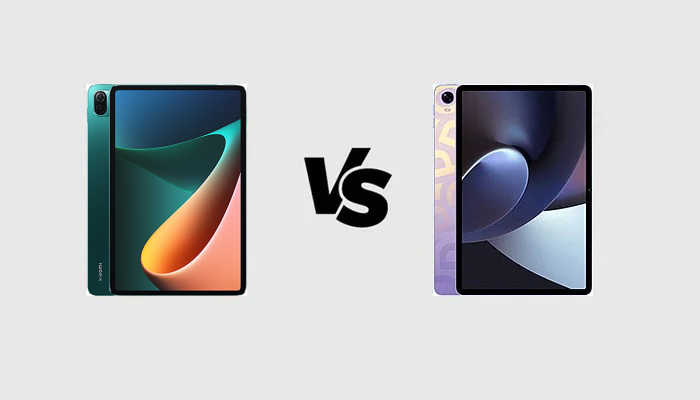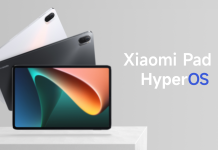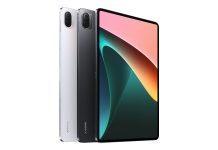This year OPPO released its first tablet ever: the OPPO Pad. Despite being the first device of its kind from this brand, it is a high-end tablet and not an entry-level one like the Realme Pad. That is the reason why it can compete directly with the Xiaomi Pad 5: a device from one of the first Chinese companies which released a tablet with a long experience in the niche. Each of these two tablets has its pros and cons, but the specs sheets are not so different after all. So which one should you go for? This is a comparison between the specifications of the OPPO Pad and the Xiaomi Pad 5 which will let you find out by listing their specifications and what changes between them.

Xiaomi Pad 5 vs OPPO Pad
| Xiaomi Pad 5 | OPPO Pad | |
|---|---|---|
| DIMENSIONS AND WEIGHT | 254.7 x 166.3 x 6.9 mm, 511 grams | 252.2 x 163.8 x 7.1 mm, 507 g |
| DISPLAY | 11 inches, 1600 x 2560p (Quad HD+), IPS LCD | 11 inches, 1600 x 2560p (Quad HD+), IPS LCD |
| PROCESSOR | Qualcomm Snapdragon 860, octa-core 2.96 GHz | Qualcomm Snapdragon 870, octa-core 3.2 GHz |
| MEMORY | 6 GB RAM, 128 GB – 6 GB RAM, 256 GB | 6 GB RAM, 128 GB – 6 GB RAM, 256 GB – 8 GB RAM, 256 GB |
| SOFTWARE | Android 11, MIUI | Android 11, ColorOS |
| CONNECTIVITY | Wi-Fi 802.11 a/b/g/n/ac, Bluetooth 5.0, GPS | Wi-Fi 802.11 a/b/g/n/ac/6, Bluetooth 5.1, GPS |
| CAMERA | 13 MP f/2.0 8 MP f/2.0 front camera |
Single 13 MP f/2.2 8 MP f/2.0 front camera |
| BATTERY | 8720 mAh, fast charging 33W | 8360 mAh, fast charging 33W |
| ADDITIONAL FEATURES | Stylus support, keyboard support | Pen support, keyboard support, reverse charging |
Design
The OPPO Pad has a very catchy design and it is more interesting than its rival in terms of aesthetics. Just like the Xiaomi Pad 5, it has very narrow bezels, but the screen-to-body ratio is a bit higher. Further, the rear side is very original and the materials are premium as it is made of aluminum. The Xiaomi Pad 5 comes with an aluminum frame and a plastic back and it has a design reminiscent of the Xiaomi Mi 11 with that pill-shaped camera module. Both the tablets are very thin and pretty lightweight to be tablets, but the Xiaomi Pad 5 is slightly thinner and lighter.
Display
Unfortunately, you do not get an OLED display with any of these tablets, but this does not mean that their IPS LCD panels are bad. If you are looking for the best display, then you should choose the Xiaomi Pad 5. It has a panel with a diagonal of 11 inches, a Quad HD+ resolution of 1600 x 2560 pixels, a 120 Hz refresh rate, the HDR10+ certification, and Dolby Vision support which is able to show up to one billion colors. The OPPO Pad has similar display specs with an 11-inch panel sporting a Quad HD+ resolution of 1600 x 2560 pixels and a 120 Hz refresh rate, but it lacks Dolby Vision support and it shows just 16 million colors. The audio is provided by good stereo speakers but none of these devices comes with a 3.5 mm audio jack.
Specs & Software
The most powerful hardware is provided by the OPPO Pad: it is fueled by the Snapdragon 870 mobile platform built at 7 nm and running at a max frequency of 3.2 GHz, paired with up to 8 GB of RAM and up to 256 GB of internal storage. With the Xiaomi Pad 5, you get a weaker Snapdragon 860 chipset with a 7 nm production process and a 2.96 GHz max frequency, paired with just 6 GB of RAM and up to 256 GB of native storage. The operating system installed on these tablets is Android 11 but the ColorOS 12 found on the OPPO Pad is particularly interesting because of the Multi-Screen connect feature allowing to achieve a seamless experience between the tablet and PCs.
Camera
The Xiaomi Pad 5 has a slightly better camera on paper: both these devices get a single 13 MP main sensor, but the Xiaomi tablet has a brighter f/2.0 focal aperture which should allow capturing clearer photos in the dark. Further, the camera of the Pad 5 is paired with a dual-LED flash (instead of the OPPO Pad) and is able to record 4K videos. The front cameras are exactly the same: two 8 MP snappers with an f/2.0 focal aperture and 1080p video recording.
- Read More: Xiaomi Mi Pad 5 & Mi Pad 5 Pro Official: 11″, 120Hz refresh rate, 5G, MIUI for Pad & more!
Battery
Despite being a thinner tablet, the Xiaomi Pad 5 is equipped with a bigger 8720 mAh battery and it provides a longer battery life in most scenarios. The OPPO Pad is the only one to support reverse charging, but with a smaller battery capacity.
Price
The starting price of the Xiaomi Pad 5 in China roughly translates into €330/$347, while you need about €310/$327 to purchase the OPPO Pad. As already mentioned, each of these tablets has its pros and cons. The Xiaomi Pad 5 provides a better display and a bigger battery, while the OPPO Pad has a higher performance and reverse charging. Which one would you pick?
Xiaomi Pad 5 vs OPPO Pad: PRO and CONS
Xiaomi Pad 5
PRO
- Great price
- Better display
- Bigger battery
- Wider availability
CONS
- Inferior hardware
OPPO Pad
PRO
- Reverse charging
- Better chipset
- More RAM
- Wi-Fi 6
CONS
- Smaller battery
RELATED







